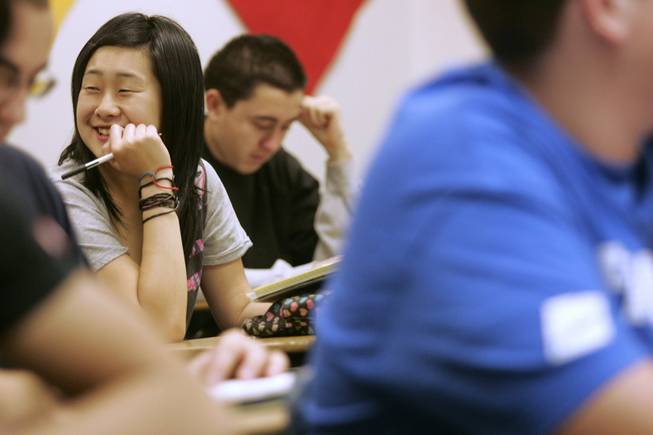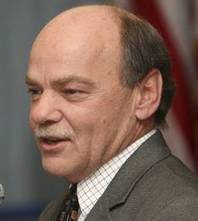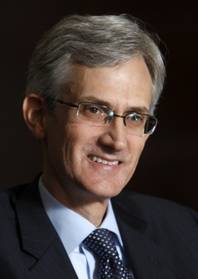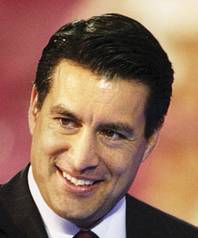
Vanna Huynh smiles while correcting a quiz during summer school at Del Sol High School Wednesday, June 16, 2010.
Thursday, June 17, 2010 | 2 a.m.
Related document
One state, many rates
41.8 percent: What a new report by Education Week says was Nevada’s graduation rate in 2007, based on the journal’s own formula.
51 percent: What Nevada says the rate would have been if the correct data had been plugged into Education Week’s formula.
67.4 percent: The graduation rate reported by the Nevada Education Department for 2007, using its own formula.

Keith Rheault

Rory Reid

Brian Sandoval
Sun coverage
Sun archives
- Ad points to accomplishments of high school seniors (6-16-2010)
- Long road to graduation: Faces of adult education (6-14-2010)
- Road to graduation runs through science test for Class of 2010 (5-27-2010)
- Superintendent suggests ways to increase graduation rates (2-11-2009)
- Graduate rates too low, dropout rates too high (1-2-2009)
Let’s get this out of the way — Nevada’s high school graduation rate, no matter which of the multitude of formulas is used to calculate it, is dismal.
But the Silver State took a particularly severe drubbing in the latest report from Education Week, a Washington-based journal, which compared graduation rates nationwide. Nevada landed in last place with just under 42 percent for the class of 2007, compared with just under 70 percent nationally.
The accuracy of the state’s graduation rate, which is often reported by the Nevada Education Department as 10 to 15 percentage points higher than the ones calculated by outside researchers, has long been a point of debate. In 2007, the year used in the report, Nevada put its rate at 67.4 percent based on a formula that 28 other states use.
Keith Rheault, Nevada’s superintendent of public instruction, has an explanation for at least part of the poor Education Week showing: Nearly 6,000 students were incorrectly counted as having dropped out between the ninth and 10th grades. Had those students been included, the graduation rate would have been 51 percent, Rheault said. (The problem stemmed from how Nevada classified its 10th-graders in 2007 — the regulations have since changed.)
The Education Week formula “is absolutely the worst formula you could generate for Nevada if you want an accurate graduation rate,” Rheault said Wednesday.
Rheault expressed his concerns in a June 9 e-mail to the project’s researchers after reviewing an advance of the report.
He asked whether the researchers had noticed the significant gap between Nevada’s graduation rate and that of the next-lowest state. The 13 percentage-point difference between Nevada’s 41.8 percent and New Mexico’s 54.9 percent was the widest gap between any two states, and should have triggered a review, Rheault said.
Reporting “a generalized graduation rate without taking into consideration the unique circumstances of an individual state does no justice to anyone,” Rheault said in his e-mail.
The report leaves the larger questions unanswered: What are the underlying issues contributing to the state’s high dropout rate? Insufficient funding for public schools? Not enough emphasis on proven preventive measures such as early childhood education? Too few opportunities for remedial help? Inadequate parenting or turbulent home lives?
However it’s calculated, Nevada has a graduation crisis on its hands.
“The most important thing to do is acknowledge that, and talk about what are you going to do about it,” said Daria Hall, director of K-12 policy development at Education Trust, a nonpartisan policy watchdog group in Washington.
Although schools can’t control students’ home lives or significantly change the broader community influences they are exposed to, “they certainly have control over the quality of instruction and the kinds of the support the student receives to stay on track to graduation,” Hall said. “Those are the things that schools and education policymakers need to be focusing on.”
Democratic gubernatorial nominee Rory Reid, who has proposed sweeping reforms of how public schools operate and are held accountable, agrees.
Instead of quibbling over the graduation rate percentages and how they were calculated, Nevada needs “fundamental reform so we can be one of the best states in the country, and not have to explain away our poor performance,” Reid said. “Let’s give people reasons to celebrate education in Nevada, attract new businesses and grow.”
Brian Sandoval, the Republican candidate for governor, has not released his education plan, but said Wednesday it would be forthcoming.
Sandoval said he was disappointed that the new report shows Nevada’s graduation rate continues to lag, adding “our state’s children deserve nothing less than the highest quality education which keeps them engaged.”
Sterling Lloyd, a senior research associate at the Editorial Projects in Education Research Center, which produced Education Week’s report, also said debate about the graduation formula should be secondary.
“Numbers are important, but those numbers represent real students,” Lloyd said. “Even using the state’s reported graduation rate, too many Nevada students are falling short of a high school diploma. That’s a concern from an economic and a human perspective.”
Based on Education Week’s calculations, no state saw a sharper decline in its graduation rate than Nevada, which dropped to 41.8 percent in 2007 from 65.7 percent in 1997. During the intervening 10 years, Clark County grew to the nation’s fifth-largest school district, with a soaring population of students from low-income households, as well as those for whom English is a second language. At the same time, the district had one of the nation’s highest transiency rates, with 35 to 40 percent of students changing schools or leaving outright during a single academic year.
“We’ve had so many challenges, it’s just not possible to fairly compare us to anywhere else,” said Sue Daellenbach, assistant superintendent for assessment and accountability.
District and state officials say they’re not giving up the public relations battle over reporting graduation rates. They intend to compile and report what they argue are more comprehensive snapshots of graduation rates, which include adjusted diplomas awarded to special education students, as well as data on students who are successful in Adult Education programs but might take longer than four years to finish course work. Neither group is currently counted as part of the “leaver” formula and both are excluded from the “cohort” formula that will be adopted next year.
The rejection of adjusted diplomas from the formula particularly rankles Rheault. Last year in Nevada 1,200 special education students completed the requirements of individualized education plans. Their adjusted diplomas are accepted for entry at the state’s colleges and universities, and at many other higher education institutions nationwide, Rheault said.
The formula Nevada and 28 other states have used is called the “leaver rate,” and had been the preferred method of the U.S. Education Department. But some critics complained it made it too easy for districts to mask the true number of dropouts by claiming students had left the area entirely.
In 2005, the nation’s governors agreed to adopt a uniform formula — known as the “cohort rate” — for calculating graduation statistics. The formula calculates the percentage of students who enter as ninth-graders and earn their diplomas within four years. The class of 2011 will be the first measured using that standard.
The adoption of the formula is good news, said Marcus Winters, a senior fellow with the Manhattan Institute in New York. As recently as a few years ago, some districts were using creative methods to claim more than 90 percent of their students had graduated, which was “absolutely fanciful,” Winters said.
“It lulled the public into believing that public schools and students were doing just fine,” said Winters, who has researched graduation rates for the conservative think tank. “Any statistic is going to be imperfect, but we’re moving closer to an honest picture. And that’s going to let us focus on where the problems really are.”
The formula adopted by the governors could be a challenge for Clark County because it will be penalized for students who leave the district without providing forwarding information indicating they are still in school. (In 2007, the district looked for the 3,791 high school students who had been enrolled the prior spring but did not return in the fall. The district was able to locate only 1,020.)
The district’s graduation rate had slowly inched upward, and was reported at 68 percent in 2009. There have been expanded efforts at helping struggling students make up missing course work and prepare for the proficiency exam, including winter break and spring vacation boot camps and summer school opportunities. Seniors who didn’t pass the required proficiency exams in time for this month’s graduation ceremonies can try again in July and still be counted as Class of 2010 graduates. But Daellenbach said she still expected the percentage to drop by 10 to 13 points when the cohort rate is adopted next year.
The recession could yield a silver lining for the district because of the expected decrease in the transiency rate over the next few years — a key factor in a student’s chances of graduating on time.
“You can get a great education in the Clark County School District,” Daellenbach said. “If you stay with us, I’d put it up against any other district in the country.”


Join the Discussion:
Check this out for a full explanation of our conversion to the LiveFyre commenting system and instructions on how to sign up for an account.
Full comments policy